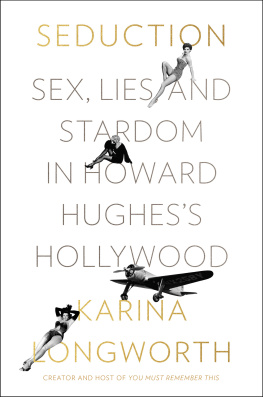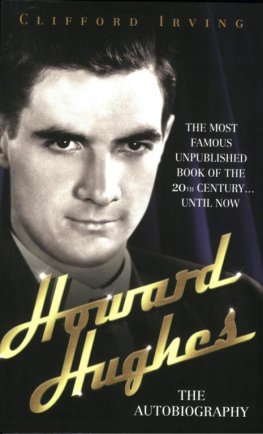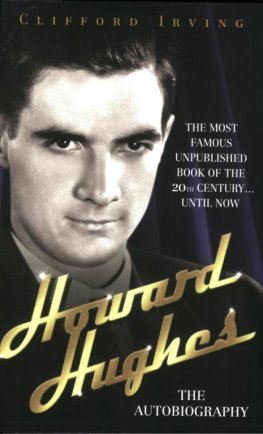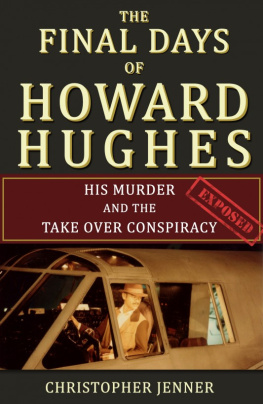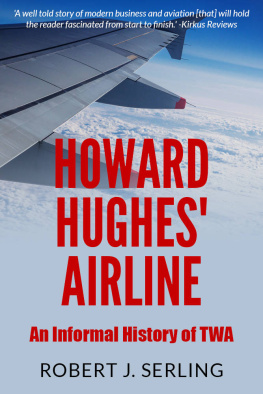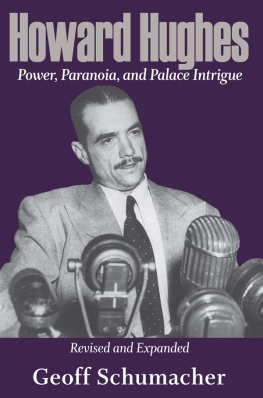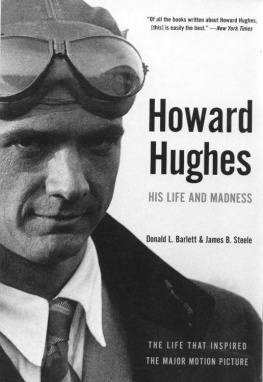Contents
Guide
For Rian
Contents
NAMES ABOVE THE TITLE
HOWARD HUGHES
Hughes defied his family by investing his inherited riches in Hollywood, beginning in 1925. As a director and producer, Hughes established a reputation for discovering female talent. Later, as the owner and manager of RKO Pictures, Hughes consistently challenged the Hollywood status quo, particularly the industrys censors. His reputation as an iconoclast was challenged only by his reputation as a playboy who romanced dozens of actresses, from the towns biggest stars to countless nameless aspirants.
BILLIE DOVE
Major silent star Billie Doves reputation was based primarily on her unusual beauty. She left both her husband and her studio when she fell in love with Howard Hughes, putting both her heart and her career into the young tycoons hands.
JEAN HARLOW
This nineteen-year-old, curvaceous blond bit player became an instant, international star after Howard Hughes cast her as the femme fatale in Hells Angels. When Hughes sold Harlows contract to MGM, she became the biggest sex symbol/comedienne of the decade.
IDA LUPINO
After appearing in several films in her native England, the bleached-blond Ida was brought to Hollywood at the age of fifteen and signed to Paramount Pictures. When blond bombshells went out of fashion, Ida transformed her career, and eventually, with Hughess support, became the only female feature film director in the Hollywood of the 1950s.
GINGER ROGERS
The biggest female dancing movie star of the 1930s, Rogers spent that decade, in partnership with Fred Astaire and on her own, dominating the box office with her persona as a hardworking, clean-living, all-American beauty.
KATHARINE HEPBURN
In the 1930s, Katharine Hepburn was Hollywoods embodiment of a woman who lived by her own rules, flouting conventional ideas about femininity and sexuality in nearly all of her films, and in her personal life.
JANE RUSSELL
Nineteen-year-old Jane Russell was introduced to the world as Hughess new bombshell in Hughess second directorial effort, The Outlaw. She would become the focal point of his experiments in suggestive promotion and the cultivation of controversy.
AVA GARDNER
Hughes pursued Gardner, a young brunette under contract at MGM who had yet to make an impact on-screen, immediately after her separation from her first husband, Mickey Rooney, made headlines.
FAITH DOMERGUE
Faith Domergue was a teenage beauty whose contract Hughes had purchased from Warner Bros. For years he promised Faith that he would marry her and make her a big movie star.
JEAN PETERS
Hughes met this brunette starlet on Fourth of July weekend, 1946a holiday that he punctuated by crashing an experimental plane into a Beverly Hills neighborhood. Like many other women before her, she believed she and Howard were in love and would marry.
TERRY MOORE
The young star of animal movies like Son of Lassie and Mighty Joe Young began dating Hughes in late 1948. Moore was a Mormon, and she would not go to bed with Hughes, until they made it official.
SECONDARY AND MINOR PLAYERS
RUPERT HUGHES
Writer, silent film director, and uncle to Howard Hughes who gave young Howard his early introduction to the Hollywood scene.
ELLA RICE HUGHES
A Texas debutante who in 1925 became Howard Hughess first wife, and moved with him from Houston to Los Angeles so that Hughes could pursue his interest in moviemaking.
LINCOLN QUARBERG
Hughess publicist from 1928 to 1932.
BEN LYON
One of the two male stars of Hells Angels, his antics were responsible for one of Hughess early PR headaches.
ANN DVORAK
Female star of Scarface who publicly accused Howard Hughes of having sold [her] down the river when he unloaded her contract to another studio.
PAT DE CICCO
An agent for cameramen who was reputed to have mob ties, De Cicco served as one of Hughess talent scouts and close confidants for many years.
BETTE DAVIS
Warner Bros. top star of the 1930s.
OLIVIA DE HAVILLAND
Daviss frequent costar who dated Hughes briefly in 193839.
RUSSELL BIRDWELL
The architect of the search for Scarlett which helped keep Gone With the Wind in the news for two years before its release, Birdwell was hired by Howard Hughes to create a similar campaign to promote Jane Russell and The Outlaw.
GLORIA VANDERBILT
Teenage heiress who dated Howard Hughes.
JOHNNY MEYER
Former aide to Errol Flynn and Warner Bros. publicist who became another of Hughess talent scouts in the early 1940s.
YVONNE DE CARLO
The future Lily Munster accompanied Hughes on the last leg of his mid-1940s walkabout from Hollywood.
LANA TURNER
MGMs top post-Harlow blonde and sometime girlfriend of Hughes.
LINDA DARNELL
Minor but incredibly beautiful brunette star who believed her affair with Hughes would lead to marriage.
GINA LOLLOBRIGIDA
Italian bombshell whom Hughes saw in a magazine and lured to Hollywood.
ROBERT MITCHUM
RKOs top male star while Hughes owned the studio from 1947 to 1955.
WALTER KANE
A key Hughes aide in the 1940s and 50s who coordinated many efforts to find and sign new contract girls.
YVONNE SCHUBERT
Probably the last contract girl with whom Hughes had a romantic or sexual relationship.
It was like something out of a movie.
The Ambassador Hotel had opened, with much fanfare, in 1921, and had since become a nexus for power, money, and fame in a Los Angeles that was not yet the sole movie capital of the universe. Over the next few years, as the East Coasts film industry dispersed west, the Ambassador, located eight miles due south of the Hollywood sign, would be a place where the fantasy worlds on-screen bled into real life. In the hotels nightclub, the Cocoanut Grove, tables were nestled and dancers nuzzled under an actual grove of papier-mch palm trees, recycled from the set of a Rudolph Valentino moviean ersatz tropics in the middle of a desert that had only recently been irrigated, and with great difficulty. With its Spanish-style main building surrounded by bungalows, and a floor plan that filled every room with sunlight and allowed for an unobstructed view straight through the building and fifteen miles out to the sea, the Ambassador had been intentionally designed as a testament to the utopian qualities of the Westboth the real things that California actually offered, and the projected fantasies for which all that wide-open space provided a blank screen.
On this night in 1925, a group of powerful Hollywood producers and executives had gathered at the Ambassador for a celebratory dinner, and, for at least some of the men assembled, a handful of fantasies were about to come true. As servers brought out dessert, the sweets were accompanied by a selection of cheesecake. Frederica Sagor, a twenty-five-year-old secretary turned screenwriter whose adaptation of the 1924 college party novel The Plastic Age was about to turn a Brooklyn tomboy named Clara Bow into a major star, watched as a group of starlets, nightclub belly dancers, and ladies of the evening sauntered toward the dinner tables. The male dinner guestsmany of them Sagors bosseslet out a drunken whoop, and soon each man was joined by a new friend. In groups of twos and threes, they began abandoning the dessert and disappearing together into bungalows.
Frederica was not surprised when her date for the evening, a sixty-something writer with whom she had been assigned by MGM to develop a feature called
Next page
